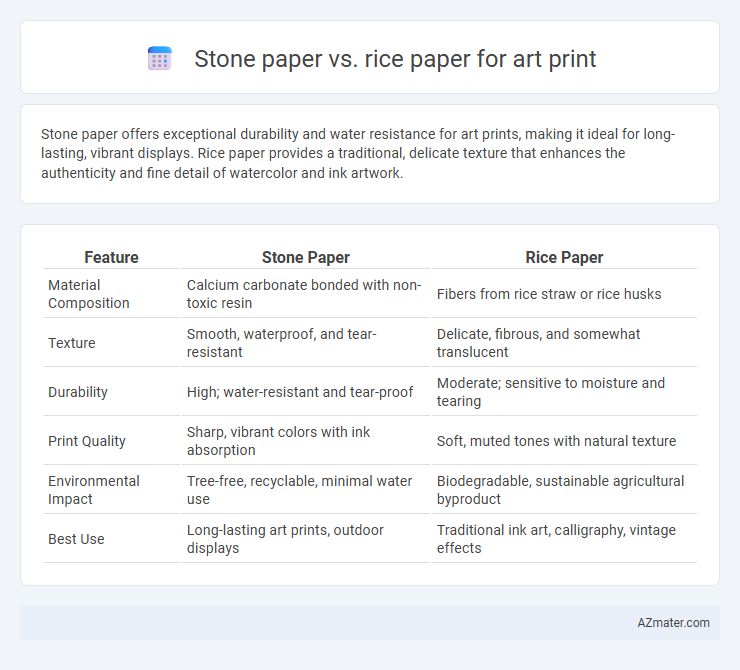Stone paper offers exceptional durability and water resistance for art prints, making it ideal for long-lasting, vibrant displays. Rice paper provides a traditional, delicate texture that enhances the authenticity and fine detail of watercolor and ink artwork.
Table of Comparison
| Feature | Stone Paper | Rice Paper |
|---|---|---|
| Material Composition | Calcium carbonate bonded with non-toxic resin | Fibers from rice straw or rice husks |
| Texture | Smooth, waterproof, and tear-resistant | Delicate, fibrous, and somewhat translucent |
| Durability | High; water-resistant and tear-proof | Moderate; sensitive to moisture and tearing |
| Print Quality | Sharp, vibrant colors with ink absorption | Soft, muted tones with natural texture |
| Environmental Impact | Tree-free, recyclable, minimal water use | Biodegradable, sustainable agricultural byproduct |
| Best Use | Long-lasting art prints, outdoor displays | Traditional ink art, calligraphy, vintage effects |
Introduction to Stone Paper and Rice Paper
Stone paper, made from calcium carbonate bonded with non-toxic resins, offers a durable, water-resistant, and eco-friendly alternative ideal for art prints seeking vivid color reproduction. Rice paper, traditionally crafted from the inner bark of rice plants or other fibers like mulberry, provides a delicate, textured surface favored for its absorbency and subtle translucence in artworks. Both materials present unique qualities for art printing, with stone paper excelling in longevity and moisture resistance, while rice paper is prized for its natural feel and traditional aesthetic.
Composition and Manufacturing Process
Stone paper is composed primarily of calcium carbonate bonded with high-density polyethylene, resulting in a durable, water-resistant surface ideal for vibrant art prints. Its manufacturing process involves grinding limestone into a fine powder and combining it with non-toxic resins, eliminating the need for water and wood pulp typically used in traditional paper production. Rice paper, made from the pith of the rice plant or rice straw fibers, involves a more labor-intensive process of soaking, beating, and drying, creating a delicate, fibrous texture best suited for traditional ink and brush strokes.
Texture and Surface Qualities
Stone paper offers a smooth, non-porous surface with exceptional opacity and brightness, providing vibrant color reproduction and sharp detail for art prints. In contrast, rice paper features a delicate, fibrous texture with a slightly translucent quality, adding a traditional, organic aesthetic but often resulting in softer image edges and less color saturation. Artists seeking durability and vividness typically prefer stone paper, while those valuing a natural, tactile feel opt for rice paper.
Durability and Longevity
Stone paper offers superior durability and longevity for art prints due to its waterproof, tear-resistant, and acid-free properties, ensuring prints remain vibrant without fading or deterioration over time. Rice paper, while prized for its delicate texture and traditional aesthetic, is more susceptible to aging effects such as yellowing, brittleness, and water damage, which can compromise the print's lifespan. Artists seeking long-lasting, resilient prints often prefer stone paper for its exceptional strength and archival quality.
Environmental Impact and Sustainability
Stone paper, made from calcium carbonate and resin, offers a sustainable alternative to traditional rice paper by eliminating the need for wood pulp and reducing deforestation. Its production consumes less water and generates no harmful chemicals, making it a more environmentally friendly option for art prints. Rice paper, derived from natural fibers like rice straw or mulberry bark, is biodegradable but often involves intensive water usage and chemical treatments, impacting its overall sustainability.
Print Color Vibrancy and Absorption
Stone paper offers superior print color vibrancy due to its smooth, non-porous surface that allows ink to sit on top without soaking in, resulting in sharper and more vivid images. Rice paper, with its fibrous and absorbent texture, tends to absorb ink deeply, which can cause color fading and less vibrant prints over time. For artists seeking intense and lasting color brilliance, stone paper provides enhanced color retention and clarity compared to the more delicate and absorbent nature of rice paper.
Suitability for Different Art Mediums
Stone paper offers superior durability and water resistance, making it ideal for ink, watercolor, and digital prints where smudging and tearing are concerns. Rice paper, with its delicate texture and absorbent qualities, is better suited for traditional Asian brush painting, calligraphy, and light washes that require fine ink flow and subtle color gradations. Each paper's unique fiber structure influences the interaction with different art mediums, guiding artists in choosing the optimal substrate for their creative techniques.
Cost Comparison and Availability
Stone paper typically costs more than rice paper due to its specialized production process using crushed stone and non-toxic resins, which also contributes to its durability and water resistance. Rice paper, made from plant fibers, is more affordable and widely available, commonly found in art and craft stores worldwide, making it a popular choice for budget-conscious artists. While stone paper offers a premium, eco-friendly alternative with longer lifespan, rice paper remains cost-effective and easily accessible for various art print applications.
Artist and Printer Preferences
Artists and printers often choose stone paper for its durability, water resistance, and smooth texture, making it ideal for high-quality art prints that require vibrant color reproduction and longevity. Rice paper offers a unique, delicate surface with a traditional aesthetic favored for calligraphy and ink artwork, appealing to artists seeking an authentic, textured finish. While stone paper accommodates modern printing techniques such as digital and offset printing, rice paper is preferred for specialized methods like brushwork and lithography that emphasize subtle textures.
Final Verdict: Best Choice for Art Prints
Stone paper offers superior durability and vibrant color retention for art prints, making it ideal for preserving intricate details and longevity. Rice paper, while traditional and textured, is more fragile and prone to yellowing, limiting its use for high-quality, lasting prints. For art prints requiring both aesthetic appeal and archival quality, stone paper emerges as the best choice.

Infographic: Stone paper vs Rice paper for Art print
 azmater.com
azmater.com